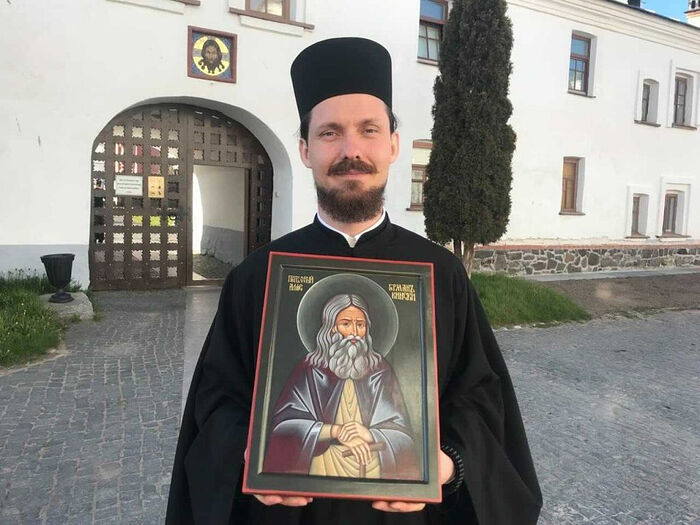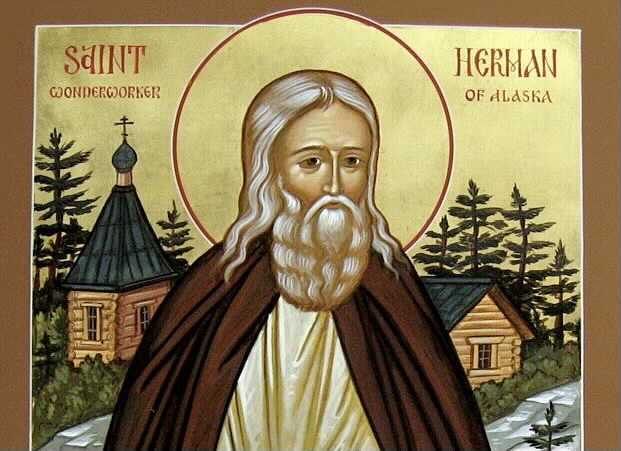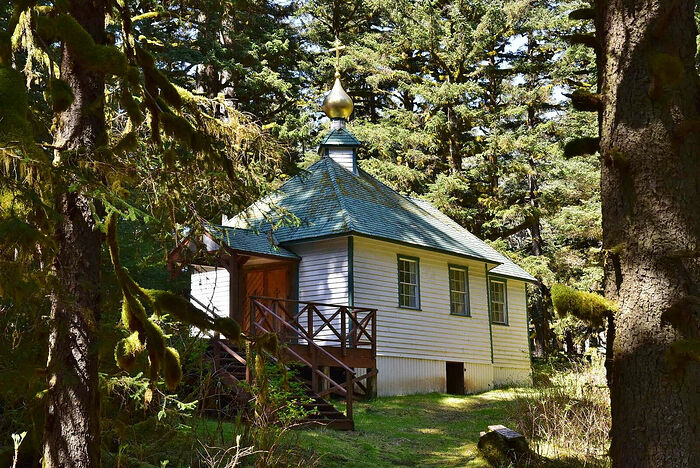“GRANDFATHER HERMAN”
Interview with Hierodeacon Herman of Valaam Monastery

St. Herman of Alaska fell asleep in the Lord on November 28 on Spruce Island. It is on this day that the saint is commemorated at Valaam Monastery. The Church honors his memory on December 25, since it was on this day that a corresponding entry was made in the parish register of the Resurrection Cathedral on Kodiak Island. Hierodeacon Herman (Murog), who labors at Valaam Monastery, was tonsured with the name, Herman. He also managed to visit Alaska. Fr. Herman believes that the trip took place with the help of his Heavenly patron.
—The story of choosing your name for monastic tonsure is interesting. Why St. Herman of Alaska?
—As a rule, when the monastery abbot, Bishop Pankraty, performs monastic tonsures, he seldom changes the names. Then there were five of us, and we approached Vladyka for a blessing. He asked me if I wished to change my name or not. I answered: “Vladyka, bless what the Lord puts in your heart.” Later I learned that some brothers had come up to him and suggested him giving me the name of St. George the New of Sofia, implying a new life for me. But I knew for sure that I would become Herman., I have venerated St. Herman of Alaska since my childhood. By the way, Vladyka Pankraty had not known about this. I remember that a monk gave me a paper icon of the saint. I thought that if I ever became a monk, I would be named after him. And not long before the tonsure I was given a piece of the saint’s coffin. St. Herman of Alaska, like me, hailed from the town of Kadom in the Ryazan Region. Both his and my secular name was Yegor, and, like me, he was tonsured at the age of thirty-one. He is connected with the United State as he preached the Gospel in America, and I am writing a thesis on the civil religion of the United States.

Then, when I was receiving the tonsure into the mantia, a miracle occurred. I had prayed in front of St. Herman’s relics, asking him to send me a Heavenly patron. I was prepared to part with this name if I had to. Vladyka asked me if there was a saint whom I venerated. “I only dare to say: Bless what the Lord puts in your heart,” I answered. And he again gave me the name Herman, but in honor of St. Herman of Valaam. It was a mystical moment. Vladyka had been unaware of these coincidences in my life. I believe it was God’s Providence.
—You mentioned that you and St. Herman of Alaska have many biographical details in common.
—St. Herman of Alaska came from the town of Kadom, Ryazan province. There he lived, was brought up and worked a civil servant. In his childhood and youth, he went to Sarov monastery and was a spiritual son of the venerable Elder Nazary, who was later elected Abbot of Valaam Monastery. Apparently, when Elder Nazary moved to Valaam, he took St. Herman with him since he was his father-confessor.
At Valaam Monastery, St. Herman at first performed general obediences, then lived in a hermitage at a distance from the monastery. Now this spot is called Germanovo Pole (“Herman’s Field”). He would visit the monastery on the major feasts. When at the request of some Russian businessmen, Catherine II (1762–1796) decided to organize a mission of monastics for the enlightenment of the Aleuts (native inhabitants of the new territories of the Russian Empire), the choice fell on Valaam Monastery, first of all because its monks were accustomed to harsh living conditions. And Monk Herman was among those who wished to go. The journey to Alaska took about a year, and he remained there forever.
—Life in Alaska was certainly not easy.
—At first, St. Herman was a baker, and he remained a simple monk till the end of his life. It was not easy to preach there—some missionary monks were killed. Thus, after Archimandrite Joasaph’s death, St. Herman headed the mission. St. Herman had to oppose the Russian merchants who mercilessly exploited the local populace, while the saint needed to tell them how good our Christian faith is and set a good example. He interceded for the Aleuts, entered into debates, did missionary work, and preached. St. Herman called himself “the lowliest servant of these peoples and their nanny.”
St. Herman of Alaska lived on Kodiak Island for twenty years. There is a city with the same name, which, by the way, is very similar to Kadom, his birthplace. It was providential too, and then St. Herman of Alaska moved to Spruce Island. In accordance with his prophecy, a monastery was founded there, which belongs to the Serbian Orthodox Church. On Spruce Island St. Herman of Alaska ended his days, having lived till almost eighty.
—Was the saint’s canonization connected with his work of enlightening the Alaskan peoples?
—St. Herman was canonized firstly for his intercession for the local population. In Alaska he was called “Apa”, which means “grandfather”. And secondly, for his missionary work. We can say that the American Orthodox Church began from Valaam. First, Orthodoxy came to Alaska thanks to Valaam monks. Then, when Alaska was sold, the see was moved to San Francisco, and then to New York.
—And what miracles of the saint are known?
—Once, for example, his prayers stopped a storm. And when the saint died, they saw a pillar of light over the island, as if St. Herman had risen to Heaven. I highly recommend the book by Sergei Korsun entitled, Venerable Herman of Alaska [Russian]. Everything is described in detail there.
—Father Herman, do you feel the saint’s participation in your life, his care and protection?
—I got the impression that the saint cares about me and loves me. I often pray to him, and always with a special feeling. Sometimes, when I am having a hard time, I feel his help. I managed to make a trip to Alaska, and it was a great mercy of God. Nothing had indicated that this trip would take place, but it did. There was the celebration of the 250th anniversary of the arrival of the first Valaam monks on the American continent, and we received a letter with an invitation from Archbishop David to take part in the celebrations. Archimandrite Elias and I obtained visas, bought tickets and set off.
—Were there any problems with the documents?
—Those in Russia who have ever received a visa to the United States know that one is required to have a personal interview. The consulates In St. Petersburg had been closed a long time before, it was impossible to sign up for an interview in Moscow, so I had to sign up for an interview in Ekaterinburg. I travelled there, everything went well, and then they sent me a passport with a visa, and everything worked out.
 The Church of Sts. Sergius and Herman, Monk's Lagoon, Spruce Island, Alaska. Photo: Orthodox Arts Journal
The Church of Sts. Sergius and Herman, Monk's Lagoon, Spruce Island, Alaska. Photo: Orthodox Arts Journal
—Where exactly did you go in Alaska? What did you see?
—There are places where you feel at home, although you have never been there before. You arrive and feel as if you were in Russia among your fellow countrymen. In this regard, there was a very good inner feeling. We visited the city of Anchorage. It is not the capital, but still the largest city in Alaska, where the airport and the cathedral are situated. Interestingly, the tonsure cross of St. Herman, the silver chalice from which he took Communion, and the icon that he brought with him have been preserved on Kodiak.
We also visited Spruce Island, another popular pilgrimage site. It was a very exciting moment for me. On the way back we had a layover in San Francisco, where we venerated St. John of Shanghai’s relics.
—What were your most vivid impressions in Alaska?
—The most striking impression was the people, who received us very cordially—they are so sincere and kind. By the way, they are often given Russian Christian names—Terenty, Ezekiel, Feodosy, Spiridon, etc. They name their children in honor of St. Maria of Radonezh and other Russian saints. They almost jump for joy as they sing. They have many Russian prayers written in the Latin alphabet for ease of pronunciation.
—What do Alaskans have that we lack in spiritual qualities?
—Sincerity! They are very receptive to the faith. Of course, this is an attribute of simple people. The Aleuts are very poor. But it seems to me this is a national trait. The Lord says, Except ye be converted, and become as little children, ye shall not enter into the Kingdom of Heaven (Mt. 18:3). So, this is about them. And it’s definitely not simulated. For example, the locals wanted to take a picture with Fr. Elias—they really liked his beautiful miter. They love beautiful vestments. They are the same as they were in the nineteenth century. This cannot be simulated—the Aleuts rejoice in simple things, things that no longer touch us as they did before.
12/25/2022


No hay comentarios:
Publicar un comentario